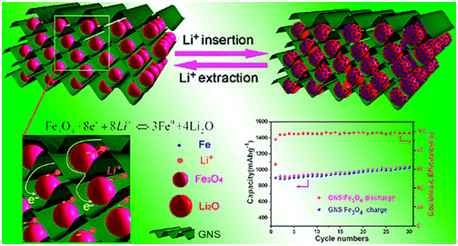G. Zhou, D.-W. Wang, F. Li*, L. Zhang, N. Li, Z.-S. Wu, L. Wen, G. Q. Lu, H.-M. Cheng*,
Chemistry of Materials 2010, 22 (18): 5306-5313.
DOI:10.1021/cm101532x [PDF]

Abstract:
A well-organized flexible interleaved composite of graphene nanosheets (GNSs) decorated with Fe3O4 particles was synthesized through in situ reduction of iron hydroxide between GNSs. The GNS/Fe3O4 composite shows a reversible specific capacity approaching 1026 mA h g−1 after 30 cycles at 35 mA g−1 and 580 mAh g−1 after 100 cycles at 700 mA g−1as well as improved cyclic stability and excellent rate capability. The multifunctional features of the GNS/Fe3O4 composite are considered as follows: (i) GNSs play a “flexible confinement” function to enwrap Fe3O4particles, which can compensate for the volume change of Fe3O4 and prevent the detachment and agglomeration of pulverized Fe3O4, thus extending the cycling life of the electrode; (ii) GNSs provide a large contact surface for individual dispersion of well-adhered Fe3O4 particles and act as an excellent conductive agent to provide a highway for electron transport, improving the accessible capacity; (iii) Fe3O4 particles separate GNSs and prevent their restacking thus improving the adsorption and immersion of electrolyte on the surface of electroactive material; and (iv) the porosity formed by lateral GNSs and Fe3O4 particles facilitates ion transportation. As a result, this unique laterally confined GNS/Fe3O4 composite can dramatically improve the cycling stability and the rate capability of Fe3O4 as an anode material for lithium ion batteries. |
